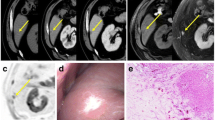Abstract
Objective
To evaluate on magnetic resonance imaging (MRI) the occurrence rate of temporal perilesional parenchymal enhancement (PPE) associated with hepatic hemangiomas in a large consecutive series and to determine which aspects are associated with this observation.
Materials and methods
Institutional review board approved this retrospective study. A computerized search of the MRI database was performed for consecutive patients between January 2008 and January 2012. The study population included 513 liver hemangiomas in 224 patients (104 males and 120 females; mean age of 55.2 ± 13.5 years; age range 24–89 years). Two readers independently reviewed the frequency of PPE, size, speed of enhancement and location of each hemangioma. Marginal models with generalized estimating equation were used. Wald test was applied to verify if the model coefficients were significant.
Results
80/513 (15.6%) hemangiomas showed PPE. The incidence of PPE was significantly higher (p < 0.05) in hemangiomas with Type1 speed of enhancement (51/80, 63.8%) than in those with Type2 or Type3. 66/80 (82.5%) hemangiomas with PPE were subcapsular (p < 0.05). Conversely, the majority (280/433, 64.7%) of hemangiomas without PPE were deep in location (p < 0.001). Lesser proportion of hemangiomas with PPE was located in segment IVa (p < 0.05).
Conclusion
PPE is not uncommonly seen along with hepatic hemangiomas. This appearance is most frequently observed in rapidly enhancing small lesions with a subcapsular location.



Similar content being viewed by others

References
Karhunen PJ (1986) Benign hepatic tumours and tumour like conditions in men. J Clin Pathol 39:183–188
Ramalho M, Altun E, Herédia V, Zapparoli M, Semelka R (2007) Liver MR imaging: 1.5T versus 3T. Magn Reson Imaging Clin N Am 15:321–347
Vilgrain V, Uzan F, Brancatelli G, et al. (2003) Prevalence of hepatic hemangioma in patients with focal nodular hyperplasia: MR imaging analysis. Radiology 229:75–79
Caseiro-Alves F, Brito J, Araújo AE, et al. (2007) Liver haemangioma: common and uncommon findings and how to improve de differential diagnosis. Eur Radiol 17:1544–1554
Semelka RC, Brown ED, Ascher SM, et al. (1994) Hepatic hemangiomas: a multi-institutional study of appearance on T2-weighted and serial gadolinium-enhanced gradient-echo MR images. Radiology 192:401–406
Kim WK, Kim AY, Kim SY, et al. (2006) Hepatic hemangiomas with arterioportal shunt: sonographic appearances with CT and MRI correlation. AJR 187:406–414
Vilgrain V, Boulos L, Vullierme MP, et al. (2000) Imaging of atypical hemangiomas of the liver with pathologic correlation. Radiographics 20:379–397
Kim YH, Shin SS, Burke LMB, et al. (2010) Hepatic subcapsular hemangioma with perilesional enhancement: MRI features. Radiol Bras 43:384–388
Byun JH, Kim TK, Lee CW, et al. (2004) Arterioportal shunt: prevalence in small hemangiomas versus that in hepatocellular carcinomas 3 cm or smaller at two-phase helical CT. Radiology 232:354–360
Jeong MG, Yu JS, Kim KW (2000) Hepatic cavernous hemangioma: temporal peritumoral enhancement during multiphase dynamic MR imaging. Radiology 216:692–697
Yu JS, Kim KW, Sung KB, Lee JT, Yoo HS (1997) Small arterio-portal venous shunts: a cause of pseudolesions at hepatic imaging. Radiology 203:737–742
Li C, Chen R, Chen W, et al. (2003) Temporal peritumoral enhancement of hepatic cavernous hemangioma: findings at multiphase dynamic magnetic resonance imaging. J Comput Assist Tomogr 27:854–859
Kim KW, Kim TK, Han JK, et al. (2001) Hepatic hemangiomas with arterioportal shunt; findings at two-phase CT. Radiology 219:707–711
Goncalves Neto JA, Altun E, Vaidean G, et al. (2009) Early contrast enhancement of the liver: exact description of subphases using MRI. Magn Reson Imaging 27:792–800
Itai Y, Matsui O (1997) Blood flow and liver imaging. Radiology 202:306–314
Yu JS, Rofsky NM (2002) Magnetic resonance imaging of arterioportal shunts in the liver. Top Magn Reson Imaging 13:165–176
Yamashita Y, Ogata I, Urata J, Takahashi M (1997) Cavernous hemangioma of the liver: pathologic correlation with dynamic CT findings. Radiology 203:121–125
Bookstein JJ, Cho KJ, Davis GB, et al. (1982) Arterioportal communications: observations and hypotheses concerning transsinusoidal and transvasal types. Radiology 142:581–590
Lane MJ, Jeffrey RB Jr, Katz DS (2000) Spontaneous intrahepatic vascular shunts. AJR 174:125–131
Michels NA (1966) Newer anatomy of the liver and its variant blood supply and collateral circulation. Am J Surg 112:337–347
Ito K, Mitchell DG, Honjo K, et al. (1997) Biphasic contrast-enhanced multisection dynamic MR imaging of the liver: potential pitfalls. Radiographics 17:693–705
Choi BI, Chung JW, Itai Y, et al. (1999) Hepatic abnormalities related to blood flow: evaluation with dual-phase helical CT. Abdom Imaging 24:340–356
Ito K, Honjo K, Fujita T, et al. (1996) Hepatic parenchymal hyperperfusion abnormalities detected with multisection dynamic MR imaging: appearance and interpretation. J Magn Reson Imaging 6:861–867
Author information
Authors and Affiliations
Corresponding author
Rights and permissions
About this article
Cite this article
Sousa, M.S.C., Ramalho, M., Herédia, V. et al. Perilesional enhancement of liver cavernous hemangiomas in magnetic resonance imaging. Abdom Imaging 39, 722–730 (2014). https://doi.org/10.1007/s00261-014-0100-6
Published:
Issue Date:
DOI: https://doi.org/10.1007/s00261-014-0100-6



